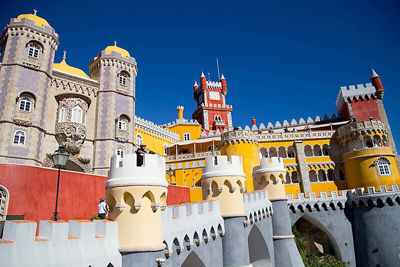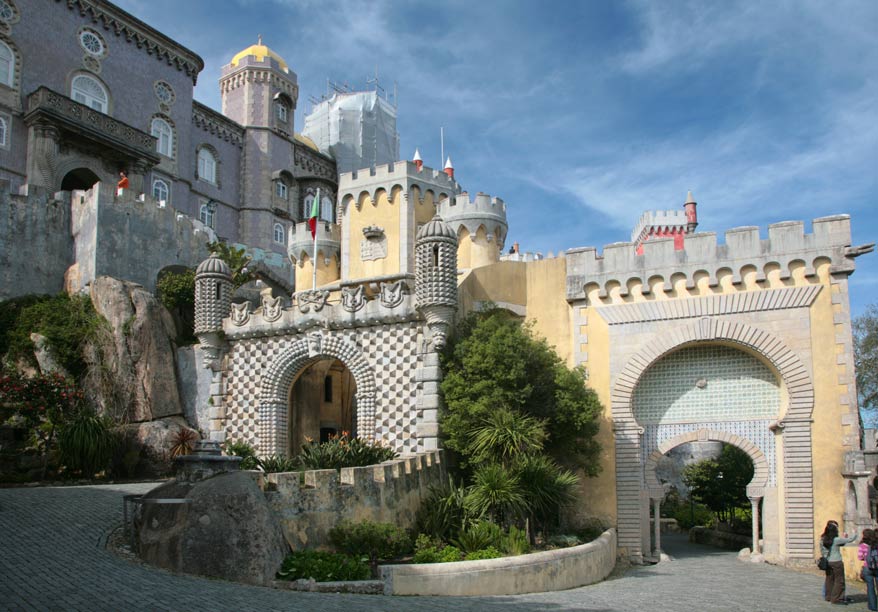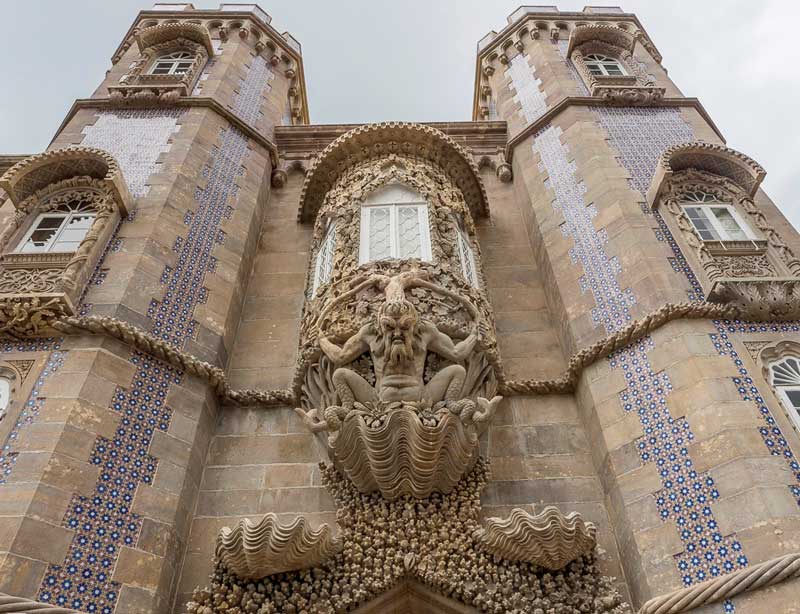
Resembling a Disney palace set on top of the hill high above the city of Sintra, on the Portuguese Riviera, the enchanting Pena National Palace or Palacio Nacional da Pena is one of the finest examples of Romanticism anywhere in the world.
Visible from Lisbon and much of its metropolitan area on a clear day, the Pena Palace, often enveloped in fog, is made of dreams. It is a tapestry of colours and blended styles that range from Romantic to Islamic to Gothic, surrounded by 500 acres of long and winding paths, lush green gardens, and exotic trees.

During the Middle Ages, the site of the palace was occupied by a relatively humble chapel, believed to be constructed after an apparition of the Virgin Mary and was dedicated to Our Lady of Pena. While King John II made a pilgrimage to the site, along with his wife Queen Leonor in 1493, his successor King Manuel I, constructed a monastery, a small and quiet place for meditation, dedicated to the Order of Saint Jerome and housing only 18 monks.
Unfortunately, in the 18th century, the monastery was severely damaged by lightning, and soon after that, the Great Lisbon Earthquake reduced it to ruins in 1755, although the chapel miraculously escaped without significant damage.

The ruins remained untouched for several decades until 1838, when Prince Ferdinand II acquired the old monastery, including its surrounding lands, the nearby Castle of the Moors, and few other estates in the area, intending to build a suitable summer palace for the Portuguese royal family and make a gift of it to his wife, Queen Maria II of Portugal. Although a German amateur architect, Wilhelm Ludwig Eschwege, was engaged for the dream project, King Ferdinand and Queen Maria decisively intervened on matters of decoration and symbolism. The vault arches, Islamic and Medieval elements, even an ornate window for the main façade was designed by the king.

The construction of the place that began in 1842, and completed in 1854, looks as if created by mashing up towers, facades, and architectural flourishes from a bunch of different castles. It has a profusion of styles that include the Neo-Gothic, Neo-Islamic, and Neo-Renaissance, amalgamated with the styles of Romanticism, influenced by Greek mythology. While a portion of the palace resembles a medieval European castle complete with ornate parapets, the next portion seems to be modeled after an Islamic tower dome. Each section of the facade is presented in a different bright colour, and strangely, a long purple wing is flanked by a red clock tower, along with a yellow minaret.

The Greek influence is evident in one of the main doorways into the inner courtyard that contains a large sculpture of Triton, the son of Poseidon and Amphitrite, squatting over the doorway, adorned with intricate motifs of waves, corals, and other nautical symbols, and carrying a huge bay window on his shoulders, symbolizing the creation of the heavens and earth. The same types of motifs can also be found all over the Palace of Pena. However, perhaps the most interesting piece of art in the palace is the bronze sculpture of a Greek goddess, housed in the study of King Ferdinand II. The statue depicting the undressing of the goddess, probably before some lenses, titled ‘Nature undresses herself before science.'

The Pen Palace is surrounded by Pen Park, covering over 200 hectares of uneven terrain and adorned with more than 2,000 species of domestic plants and plants from distant countries procured by King Ferdinand II, adapting to the rugged terrain character of the area rather than reshaping it. The park has a long and winding system of paths and narrow roads with ups and downs, connecting the palace, as well as to its two gated exits.
Years after the death of Queen Maria, Ferdinand fell in love and married Elise Henster, a highly educated, Swiss-born American opera singer and actress, whom he elevated to the Countess of Edla. After the death of the king, Countess of Edla sold the palace to King Louis, the second son of Queen Maia II, and in 1889 it was purchased by the Portuguese State.

However, when King Manuel II was deposed by a military coup, later known as the 5 October Revolution of 1910, and resulted in the establishment of the Portuguese Republic, the Queen Mother Amélia, the last Queen of Portugal, left the Pen Palace and Portugal forever with the rest of the royal family and went into exile. She lived most of her remaining life in France and declined to return when the Portuguese government invited her during World War II.
Since the days when the royal family left the palace, it was left abandoned and neglected for a prolonged period and fell into disrepair. The red and yellow colours of its facades faded miserably, and for many years the palace looked entirely grey. However, after a long wait, the palace was repaired, repainted, and the original colours were finally restored by the end of the 20th century, and in 1995 it was classified as a World Heritage Site by UNESCO.